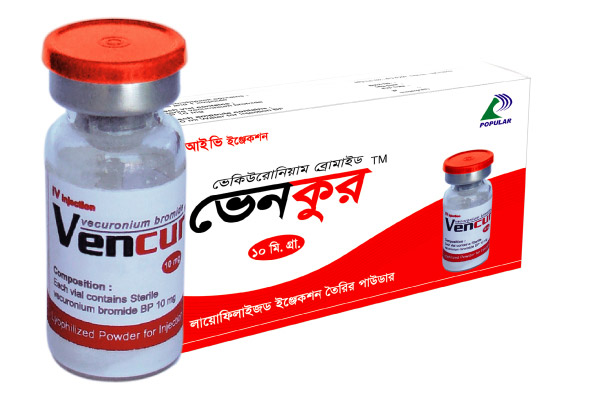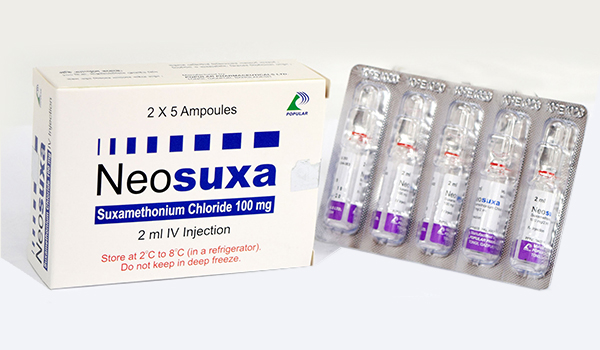Indication
VencurTM is indicated as an adjunct to general anaesthesia to facilitate endotracheal intubation and to provide skeletal muscle relaxation during surgery or mechanical ventilation.
Dosage & Administration
The recommended initial dose of Vecuronium is 0.08 to 0.10 mg/kg body weight given as an I.V. bolus injection. This dose can be expected to produce good or excellent non-emergency intubation conditions in 2.5 to 3.0 minutes after injection. In caesarean section and neonatal surgery the dose should not exceed 0.1 mg/kg. Like other neuromuscular blocking agents, VencurTM should only be administered by, or under supervision of, experienced clinicians who are familiar with the action and use of these agents; the dosage of VencurTM should be individualized in each patient. Consequently, adjustments with VencurTM should be made by administering smaller maintenance doses at less frequent intervals or by using lower infusion rates of VencurTM during long lasting procedures (longer than 1 hour) under inhalational anaesthesia. In adult patients the following dosage recommendations may serve as a general guideline for tracheal intubation and muscle relaxation for short to long lasting surgical procedures. Tracheal intubation: The standard intubating dose during routine anaesthesia is 0.08 to 0.1 mg Vecuronium Bromide per kg body weight, after which adequate intubation conditions are established within 90 to 120 seconds in nearly all patients. Dosages of VencurTM for surgical procedures after intubation with suxamethonium: If suxamethonium is used for intubation, the administration of Vecuronium should be delayed until the patient has clinically recovered from the neuromuscular block induced by suxamethonium. Recommended dose is 0.03 to 0.05 mg Vecuronium Bromide per kg body weight. Maintenance dosing: The recommended maintenance dose is 0.02 to 0.03 mg Vecuronium Bromide per kg body weight. These maintenance doses should best be given when twitch height has recovered to 25% of control twitch height. Dose requirements for administration of VencurTM by continuous infusion: If Vecuronium is administered by continuous infusion, it is recommended to give a loading dose (0.08 to 0.1 mg Vecuronium Bromide per kg body weight) first and, when neuromuscular block starts to recover, to start administration of Vecuronium by infusion. The infusion rate should be adjusted to maintain twitch response at 10% of control twitch height or to maintain 1 to 2 responses to train of four stimulation. In adults, the infusion rate required to maintain neuromuscular block at this level, ranges from 0.8 to 1.4 μg Vecuronium Bromide/kg/min. Repeat monitoring of neuromuscular block is recommended since infusion rate requirements vary from patient to patient and with the anaesthetic method used. Dosing in elderly patients: The same intubation and maintenance doses as for younger adults (0.08-0.1 mg/kg and 0.02-0.03 mg/kg, respectively) can be used. The onset time in elderly is similar to younger adults. Dosing in paediatric patients: Neonate (up to 4 weeks) and children up to 4 months: initial test dose 0.01 to 0.02 mg/kg then incremental doses until 90% to 95% depression of twitch response is achieved is recommended. In neonatal surgery the dose should not exceed 0.1 mg/kg. Children over 5 months to 10 years: 0.08-0.1 mg/kg (children under 12 months, onset more rapid and high intubation dose may not be required); maintenance 0.02-0.03 mg/kg adjusted according to response. Since the duration of action is shorter in children, maintenance doses are required more frequently. Dosing in overweight and obese patients: When used in overweight or obese patients doses should be reduced taking into account an ideal body weight. Larger doses in individual patients: Initial doses ranging from 0.15 mg up to 0.30 mg Vecuronium Bromide per kg body weight have been administered during surgery both under halothane and neurolept anaesthesia.
Method of Administration
VencurTM should be administered following reconstitution. VencurTM is administered intravenously either as a bolus injection or as a continuous infusion. Reconstitution: Alternatively, in order to obtain a solution with a lower concentration, VencurTM 10 mg may be reconstituted with a volume up to 10 ml respectively of the following infusion fluids: l 5% glucose IV solution l 0.9% sodium chloride IV solution l Lactated Ringer's solution l Lactated Ringer's and 5% glucose IV solution l Glucose 5% and 0.9% sodium chloride IV solution
Precautions
Allergic cross-reactivity between neuromuscular blocking agents has been reported; caution is advised in cases of hypersensitivity to these drugs. Their activity is prolonged in patients with myasthenia gravis and in hypothermia, therefore lower doses are required. Non-depolarising muscle relaxants should be used with great care in those with other neuromuscular disorders and those with fluid and electrolyte disturbances, as response is unpredictable. Resistance may develop in patients with burns who may require increased doses; low plasma cholinesterase activity in these patients requires dose titration for mivacurium. General: Vecuronium should be
administered in carefully adjusted dosage by or under the supervision of experienced clinicians who are familiar with its actions and the possible complications that might occur following its use. The drug should not be administered unless facilities for intubation, artificial respiration, oxygen therapy, and reversal agents are immediately available. The clinician must be prepared to assist or control respiration. A peripheral nerve stimulator should be employed to monitor drug response, need for additional relaxant, and adequacy of spontaneous recovery or anticholinesterase antagonism. Intensive Care Unit: To reduce the possibility of prolonged neuromuscular blockade and other complications that might occur following long-term use in the ICU, Vecuronium or any other neuromuscular blocking agent should be administered in carefully adjusted doses by or under the supervision of experienced clinicians who are familiar with its actions and with appropriate peripheral nerve stimulator muscle monitoring techniques. Neuromuscular Disease: In patients who are known to have myasthenia gravis or the myasthenic syndrome, small doses of Vecuronium may have profound effects. In such patients, a peripheral nerve stimulator and use of a small test dose may be of particular value in assessing and monitoring dosage requirements.
Use in Pregnancy and Lactation
There are insufficient data on the use of Vecuronium during animal or human Pregnancy to assess potential harm to the foetus. Vecuronium should be given to a pregnant woman only when the attending physician decides that the benefits outweigh the risks. There are no human data on the use of Vecuronium during lactation. Vecuronium should be given to lactating women only when the attending physician decides that the benefits outweigh the risks. Caesarean section: Studies with Vecuronium, administered in doses up to 0.1 mg/kg, have shown its safety for use in caesarean section. In caesarean section the dose should not exceed 0.1 mg/kg. In several clinical studies Vecuronium did not affect Apgar score, foetal muscle tonus or cardio respiratory adaptation. From umbilical cord blood sampling it is apparent that only very little placental transfer of vecuronium occurs which did not lead to the observation of any clinical adverse effect in the newborn.



